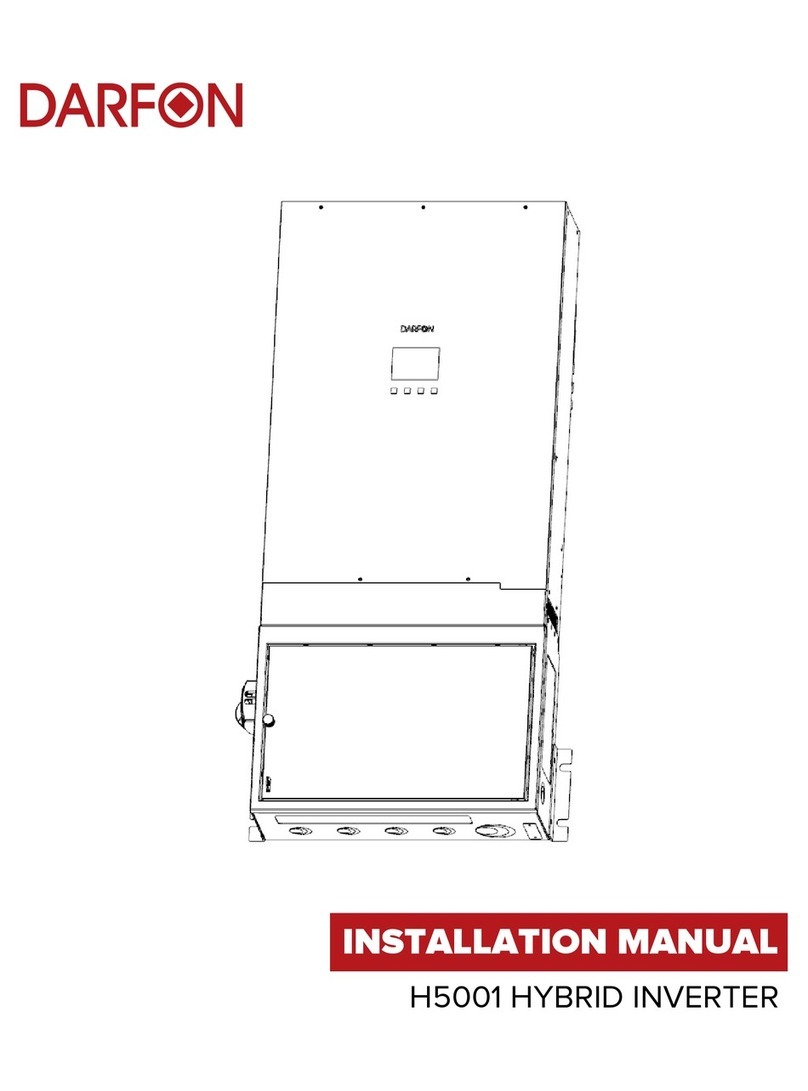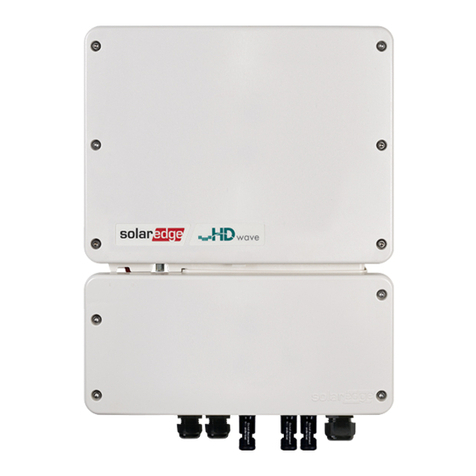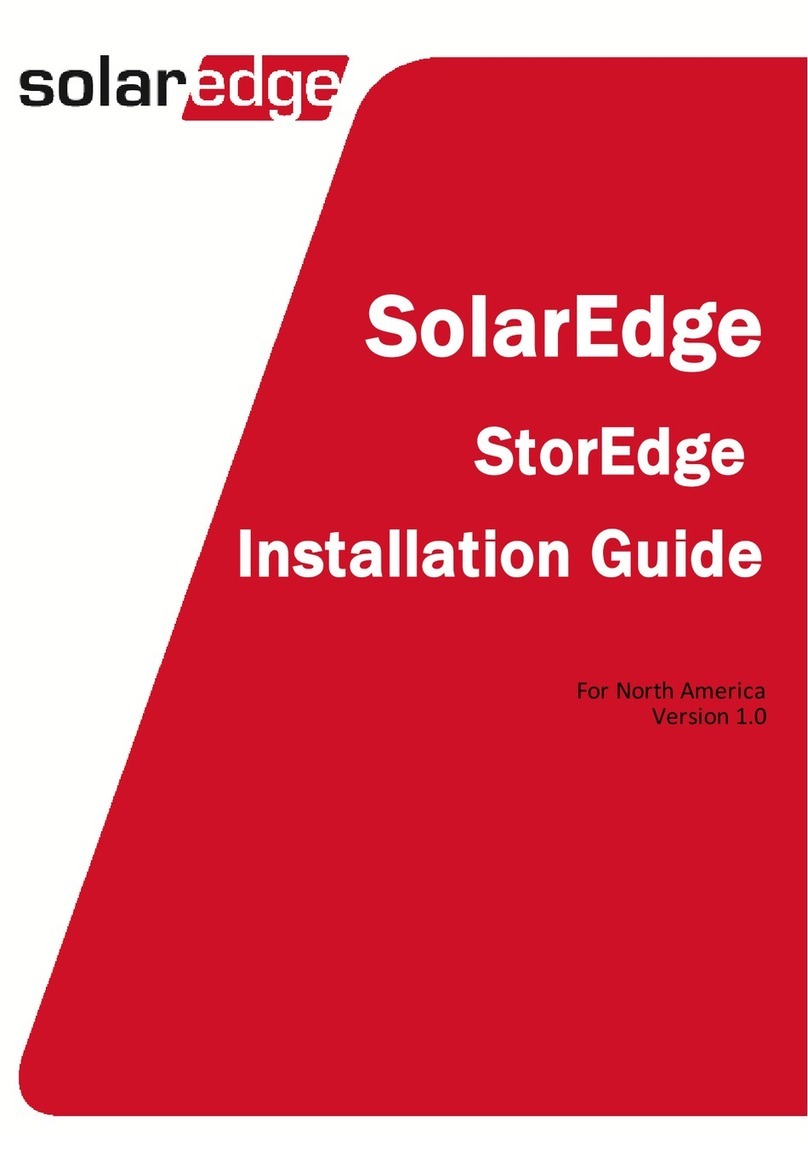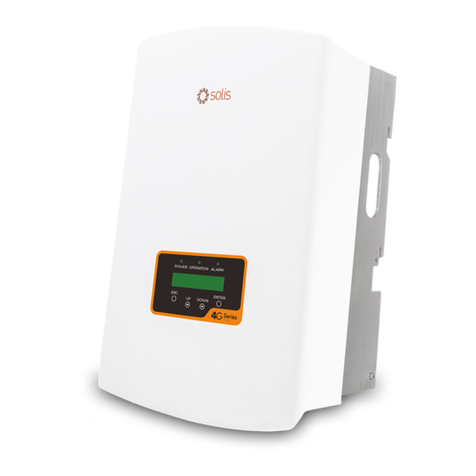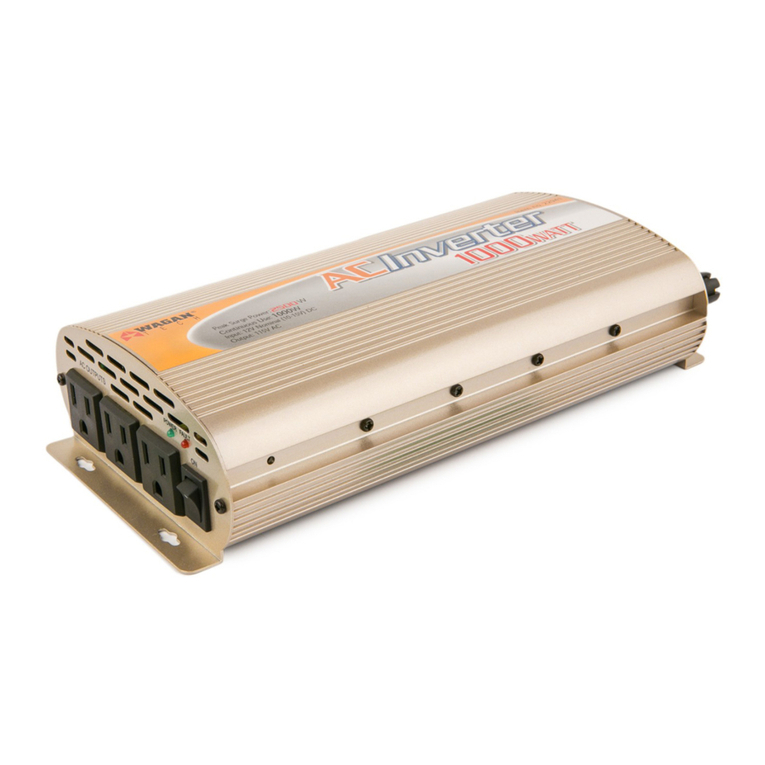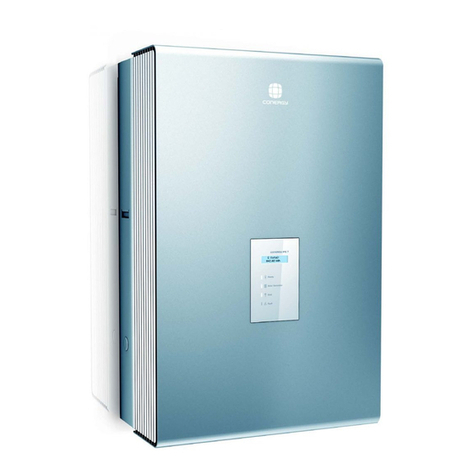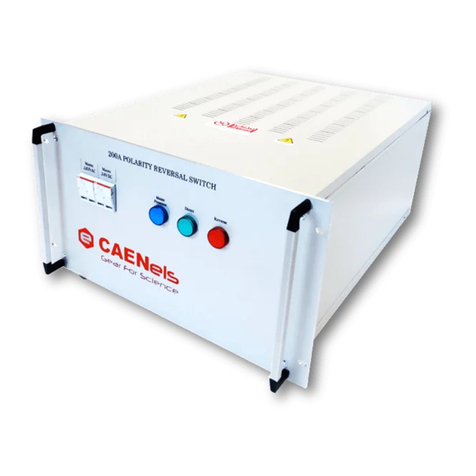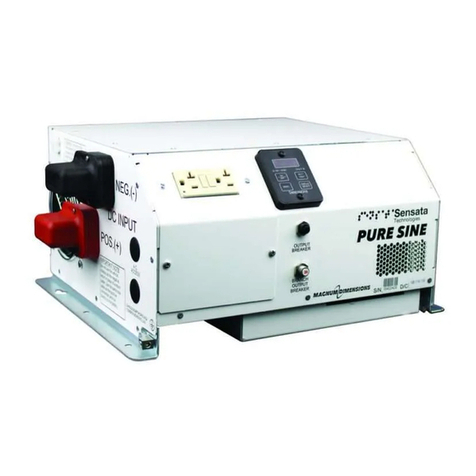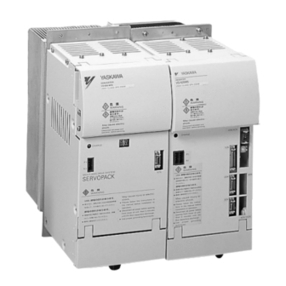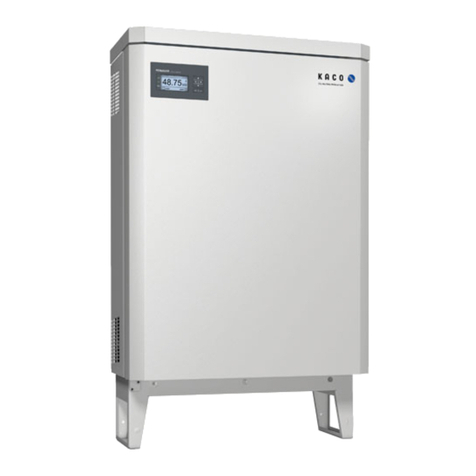Neoenerji 4KVA User manual

4KVA/ 5KVA
INVERTER / CHARGER
User Manual
www.neoenerji.com

CONTENTS
ABOUT THIS MANUAL .....................................................................................................................................1
Purpose............................................................................................................................................................1
Scope...............................................................................................................................................................1
SAFETY INSTRUCTIONS..................................................................................................................................1
INTRODUCTION ...............................................................................................................................................2
Features...........................................................................................................................................................2
Basic System Architecture...............................................................................................................................2
Product Overview.............................................................................................................................................3
Operation Diagrams and work conditions........................................................................................................4
INSTALLATION...................................................................................................................................................7
Unpacking and Inspection................................................................................................................................7
Preparation ......................................................................................................................................................7
Mounting the Unit.............................................................................................................................................7
Battery Connection ..........................................................................................................................................8
AC Input/Output Connection............................................................................................................................9
PV Connection (Only apply for the model with solar charger).......................................................................10
Final Assembly...............................................................................................................................................11
OPERATION .....................................................................................................................................................12
Power ON/OFF ..............................................................................................................................................12
Operation and Display Panel.........................................................................................................................12
LCD Display Icons .........................................................................................................................................13
LCD Setting....................................................................................................................................................15
Display Setting...............................................................................................................................................16
Operating Mode Description..........................................................................................................................18
Fault Reference Code....................................................................................................................................19
Warning Indicator...........................................................................................................................................20
SPECIFICATIONS ...........................................................................................................................................21
Table 1 Line Mode Specifications ...................................................................................................................21
Table 2 Invert Mode Specifications ................................................................................................................22
Table 3 Charge Mode Specifications ..............................................................................................................23
Table 4 General Specifications .......................................................................................................................23
Charging Controls...........................................................................................................................................23
TROUBLE SHOOTING.....................................................................................................................................24
Appendix: Approximate Back-up Time Table ...........................................................................................25
www.neoenerji.com

1
ABOUT THIS MANUAL
Purpose
This manual describes the assembly, installation, operation and troubleshooting of this unit. Please read
this manual carefully before installations and operations. Keep this manual for future reference.
Scope
This manual provides safety and installation guidelines as well as information on tools and wiring.
SAFETY INSTRUCTIONS
WARNING: This chapter contains important safety and operating instructions. Read and
keep this manual for future reference.
1. Before using the unit, read all instructions and cautionary markings on the unit, the batteries and all
appropriate sections of this manual.
2. CAUTION --To reduce risk of injury, charge only deep-cycle lead acid type rechargeable batteries.
Other types of batteries may burst, causing personal injury and damage.
3. Do not disassemble the unit. Take it to a qualified service center when service or repair is required.
Incorrect re-assembly may result in a risk of electric shock or fire.
4. To reduce risk of electric shock, disconnect all wirings before attempting any maintenance or cleaning.
Turning off the unit will not reduce this risk.
5. CAUTION –Only qualified personnel can install this device with battery.
6. NEVER charge a frozen battery.
7. For optimum operation of this inverter/charger, please follow required spec to select appropriate cable
size. It’s very important to correctly operate this inverter/charger.
8. Be very cautious when working with metal tools on or around batteries. A potential risk exists to drop
a tool to spark or short circuit batteries or other electrical parts and could cause an explosion.
9. Please strictly follow installation procedure when you want to disconnect AC or DC terminals. Please
refer to INSTALLATION section of this manual for the details.
10. Fuses (4 pieces of 30A, 150VDC for 4KVA and 5pcs of that for 5KVA) are provided as over-current
protection for the battery supply.
11. GROUNDING INSTRUCTIONS -This inverter/charger should be connected to a permanent grounded
wiring system. Be sure to comply with local requirements and regulation to install this inverter.
12. NEVER cause AC output and DC input short circuited. Do NOT connect to the mains when DC input
short circuits.
13. Warning!! Only qualified service persons are able to service this device. If errors still persist after
following troubleshooting table, please send this inverter/charger back to local dealer or service center
for maintenance.
www.neoenerji.com

2
INTRODUCTION
This is a multi-function inverter/charger, combining functions of inverter, solar charger and battery charger to
offer uninterruptible power support with portable size. Its comprehensive LCD display offers user-configurable
and easy-accessible button operation such as battery charging current, AC/solar charger priority, and
acceptable input voltage based on different applications.
Features
Pure sine wave inverter
Configurable input voltage range for home appliances and personal computers via LCD setting
Configurable battery charging current based on applications via LCD setting
Configurable AC/Solar Charger priority via LCD setting
Compatible to mains voltage or generator power
Auto restart while AC is recovering
Overload/ Over temperature/ short circuit protection
Smart battery charger design for optimized battery performance
Cold start function
Basic System Architecture
The following illustration shows basic application for this inverter/charger. It also includes following devices to
have a complete running system:
Generator or Utility.
PV modules (option)
Consult with your system integrator for other possible system architectures depending on your requirements.
This inverter can power all kinds of appliances in home or office environment, including motor-type appliances
such as tube light, fan, refrigerator and air conditioner.
Figure 1 Hybrid Power System
www.neoenerji.com

3
Note: Appliances such as air conditioner are required at least 2~3 minutes to restart because it’s required
to have enough time to balance refrigerant gas inside of circuits. If a power shortage occurs and
recovers in a short time, it will cause damage to your connected appliances. To prevent this kind of
damage, please check manufacturer of air conditioner if it’s equipped with time-delay function
before installation. Otherwise, this inverter/charger will trig overload fault and cut off output to
protect your appliance but sometimes it still causes internal damage to the air conditioner.
Product Overview
1. LCD display
2. Status indicator
3. Charging indicator
4. Fault indicator
5. Function buttons
6. Power on/off switch
7. AC input
8. AC output
9. PV input
10. Battery input
11. Circuit breaker
12. RS-232 communication port
www.neoenerji.com

4
Operation Diagrams and Working Conditions
Abbreviation:
IUC, charging current from AC charger
ISC, charger current from solar charger
ICHG, total charging current of battery
IDISC, discharging current from battery
ILOAD, output current of AC load
CSF, Solar Charge First
CUF, Utility Charge First
CS+UF, Solar & Utility Charge at the same time
OSF, Output Solar First
OUF, Output Utility First
The device working status is determined by the states of inputs, the power on/off status, charging priority and
output priority setting. Please refer to the following table for the device’s work state.
Solar
Utility
Battery
Power
on/off
Switch
Output
Priority
Charge
Priority
State
--
LOSS
OK
ON
--
--
BAT AC OUTPUT
OK
LOSS
LOW
--
--
--
SOLAR CHARGE WITHOUT OUTPUT
OK
LOSS
OK
OFF
--
--
SOLAR CHARGE WITHOUT OUTPUT
LOSS
OK
--
--
--
CUF,CS+UF
AC CHARGE
LOSS
OK
--
--
--
CSF
NO CHARGE
OK
OK
LOW
--
--
CUF
AC CHARGE
OK
OK
LOW
ON
--
CSF
SOLAR CHARGE WITH OUTPUT
OK
OK
LOW
OFF
--
CSF
SOLAR CHARGE WITHOUT OUTPUT
OK
OK
LOW
--
--
CS+UF
AC & SOLAR CHARGE
OK
OK
OK
OFF
OSF
CSF
SOLAR CHARGE WITHOUT OUTPUT
OK
OK
OK
OFF
OSF
CUF
AC CHARGE
OK
OK
OK
OFF
OSF
CS+UF
AC & SOLAR CHARGE
OK
OK
OK
ON
OSF
--
BAT MODE
OK
OK
OK
--
OUF
CUF
AC CHARGE
OK
OK
OK
ON
OUF
CSF
SOLAR CHARGE WITH OUTPUT
OK
OK
OK
OFF
OUF
CSF
SOLAR CHARGE WITHOUT OUTPUT
OK
OK
OK
--
OUF
CS+UF
AC & SOLAR CHARGE
1) BAT AC OUTPUT
Solar Charger
Utility Source
Solar Source
Battery Bank
DC/AC Inverter AC Load
ILOAD
Isc IDISC
www.neoenerji.com

5
The load is powered by battery power and solar power. Solar charger works when solar power is OK. The
maximum ISC will go up to 50Amp. Then, the status of solar power and connected load will determine if battery
is charge or discharge.
2) SOLAR CHARGE WITHOUT OUTPUT
Solar Charger
Utility Source
Solar Source
Battery Bank
DC/AC Inverter AC Load
Isc
Solar charges the battery. The Max. ISC goes up to 50Amp if solar panel with enough energy. No load is powered
at this state.
3) SOLAR CHARGE WITH OUTPUT
Solar Charger
Utility Source
Solar Source
Battery Bank
DC/AC Inverter AC Load
Isc ILOAD
The load is powered by the utility. Solar power charges the battery. The maximum ISC will go up to 50Amp if
enough energy is generated by solar modules.
4) AC CHARGE
Solar Charger
Utility Source
Solar Source
Battery Bank
DC/AC Inverter AC Load
Iuc ILOAD
The battery is charged by the utility. The maximum IUC is 30Amp. The solar charger doesn’t work. When the
power ON/OFF switch is turned “ON”, the device will generate output to the load. When the power ON/OFF
switch is turned “OFF”, the device won’t generate output to the load.
www.neoenerji.com

6
5) AC & SOLAR CHARGE
Solar Charger
Utility Source
Solar Source
Battery Bank
DC/AC Inverter AC Load
Iuc ILOAD
Isc
The battery is charged by the utility and solar power at the same time. ICHG = IUC + ISC and the maximum ICHG
is 50Amp. When the power ON/OFF switch is turned “ON’, the device will generate output to the load. If the
power ON/OFF switch is turned “OFF”, the device won’t generate output to the load.
6) NO CHARGE
Solar Charger
Utility Source
Solar Source
Battery Bank
DC/AC Inverter AC Load
ILOAD
When the power ON/OFF switch is turned “ON”, the device will generate output to the load. If the power
ON/OFF switch is turned “OFF”, the device won’t generate output to the load. There is no charging current to
the battery.
www.neoenerji.com

7
INSTALLATION
Unpacking and Inspection
Before installation, please inspect the unit. Be sure that nothing inside the package is damaged. You should
have received the following items inside of package:
The unit x 1
User manual x 1
Communication cable x 1
Preparation
Before connecting all wirings, please take off bottom cover by removing two screws as shown below.
Mounting the Unit
Consider the following points before selecting where to install:
Do not mount the inverter on flammable construction
materials.
Mount on a solid surface
Install this inverter at eye level in order to allow the LCD
display to be read at all times.
For proper air circulation to dissipate heat, allow a clearance
of approx. 10 cm to the side and approx. 50 cm above and
below the unit.
The ambient temperature should be between 0°C and 55°C
to ensure optimal operation.
The recommended installation position is to be adhered to
the wall vertically.
Be sure keep other objects and surfaces as shown in the
below diagram to guarantee sufficient heat dissipation and
to have enough space for removing wires.
SUITABLE FOR MOUNTING ON CONCRETE OR OTHER NON-COMBUSTIBLE SURFACE ONLY.
www.neoenerji.com

8
Install the unit by screwing three screws.
Battery Connection
CAUTION: To safety operation and regulation compliance, it’s requested to install a separate DC over-current
protector or disconnect device between battery and inverter. It may not be requested to have a disconnect
device in some applications, however, it’s still requested to have over-current protection installed. Please refer
to typical amperage in below table as required fuse or beaker size.
WARNING! All wiring must be performed by a qualified personnel.
WARNING! It's very important for system safety and efficient operation to use appropriate cable for battery
connection. To reduce risk of injury, please use the proper recommended cable and terminal size as below.
Recommended battery cable and terminal size:
Model
Typical
Amperage
Battery
capacity
1~3 m one-way
Ring Type for Cable
Terminal
Torque value
4KVA
67A
200AH
1*4AWG
KST: RNBS22-6
2~ 3 Nm
2*8AWG
KST: RNBS14-6
5KVA
84A
200AH
1*4AWG
KST: RNBS22-6
2~ 3 Nm
2*8AWG
KST: RNBS14-6
Please follow below steps to implement battery connection:
1. Assemble battery ring terminal based on recommended battery cable and terminal size.
2. This model supports 48VDC system. It’s suggested to connect at least 200Ah capacity battery.
NOTE: Please only use sealed lead acid battery or sealed GEL/AGM lead-acid battery.
3. Insert the ring terminal of battery cable flatly into battery connector on the inverter and make sure the
bolts are tightened to a torque of 2-3 Nm. Make sure polarity at both the battery and the inverter/charge is
correctly connected and ring terminals are tightly screwed to the battery terminals.
www.neoenerji.com

9
WARNING: Shock Hazard
Installation must be performed with care due to high battery voltage in series.
CAUTION!! Do not place anything between the flat part of the inverter terminal and the ring
terminal. Otherwise, overheating may occur.
CAUTION!! Do not apply anti-oxidant substance on the terminals before terminals are
connected tightly.
CAUTION!! Before making the final DC connection or closing DC breaker/disconnector, be sure
positive (+) must be connected to positive (+) and negative (-) must be connected to negative
(-).
AC Input/Output Connection
CAUTION!! Before connecting to AC input power source, please install a separate AC breaker between
inverter and AC input power source. This will ensure the inverter can be securely disconnected during
maintenance and fully protected from over current of AC input. The recommended spec of AC breaker is 40A
for 4KVA and 50A for 5KVA.
CAUTION!! There are two terminal blocks with “IN” and “OUT” markings. Please do NOT mis-connect input
and output connectors.
WARNING! All wiring must be performed by a qualified personnel.
WARNING! It's very important for system safety and efficient operation to use appropriate cable for AC input
connection. To reduce risk of injury, please use the proper recommended cable size as below.
Suggested cable requirement for AC wires
Model
AWG no.
Torque
4KVA
10 AWG
1.4~1.6Nm
5KVA
8 AWG
1.4~1.6Nm
Please follow below steps to implement AC input/output connection:
1. Before making AC input/output connection, be sure to open DC protector or disconnector first.
2. Remove insulation sleeve 10mm for six conductors. And shorten phase L and neutral conductor N 3 mm.
3. Insert AC input wires according to polarities indicated on terminal block and tighten the terminal screws. Be
sure to connect PE protective conductor ( ) first.
L→LINE (brown or black)
→Ground (yellow-green)
N→Neutral (blue)
www.neoenerji.com

10
WARNING:
Be sure that AC power source is disconnected before attempting to hardwire it to the unit.
4. Then, insert AC output wires according to polarities indicated on terminal block and tighten terminal screws.
Be sure to connect PE protective conductor ( ) first.
L→LINE (brown or black)
→Ground (yellow-green)
N→Neutral (blue)
5. Make sure the wires are securely connected.
PV Connection (Only apply for the model with solar charger)
CAUTION: Before connecting to PV modules, please install separately a DC circuit breaker between inverter
and PV modules.
WARNING! All wiring must be performed by a qualified personnel.
WARNING! It's very important for system safety and efficient operation to use appropriate cable for PV
module connection. To reduce risk of injury, please use the proper recommended cable size as below.
Model
Typical Amperage
Cable Size
Torque
4KVA/5KVA
50A
8 AWG
1.4~1.6 Nm
Please follow below steps to implement PV module connection:
1. Remove insulation sleeve 10 mm for positive and negative conductors.
2. Check correct polarity of connection cable from PV modules and PV input
connectors. Then, connect positive pole (+) of connection cable to positive
pole (+) of PV input connector. Connect negative pole (-) of connection
cable to negative pole (-) of PV input connector.
www.neoenerji.com

11
3. Make sure the wires are securely connected.
Final Assembly
After connecting all wirings, please put bottom cover back by screwing two screws as shown below.
Communication Connection
This inverter/charger is equipped with a communication port to communicate with a PC with corresponding
software. Please use supplied communication cable to connect to RS-232 of this inverter and RS-232 port of
the PC. Please access software download site to download the monitoring software in your PC. Software
download website: www.power-software-download.com/watchpower.html. For the detailed software
operation, please check user manual of software.
www.neoenerji.com

12
OPERATION
Power ON/OFF
Once the unit has been properly installed and the batteries are connected well, simply press On/Off switch
(located on the button of the case) to turn on the unit.
Operation and Display Panel
The operation and display panel, shown in below chart, is on the front panel of the inverter. It includes
three indicators, four function keys and a LCD display, indicating the operating status and input/output
power information.
LED Indicator
LED Indicator
Messages
Green
Solid On
Output is available in bypass mode
Flashing
Output is powered by battery in inverter mode
Green
Solid On
Battery is fully charged
Flashing
Battery is charging.
Red
Solid On
Fault mode
Flashing
Warning mode
Function Keys
Function Key
Description
ESC
Exit setting mode
UP
To previous selection
DOWN
To next selection
ENTER
To confirm the selection in setting mode or enter setting mode
LCD display
LED indicators
Function keys
www.neoenerji.com

13
LCD Display Icons
Icon
Function description
Input Source Information
Indicates the AC input.
Indicates the PV input
Indicate input voltage, input frequency, PV voltage, battery voltage and
charger current.
Configuration Program and Fault Information
Indicates the setting programs.
Indicates the warning and fault codes.
Warning: flashing with warning code.
Fault: lighting with fault code
Output Information
Indicate output voltage, output frequency, load percent, load in VA and load in
Watt.
Battery Information
Indicates battery level by 0-24%, 25-49%, 50-74% and 75-100% in battery
mode and charging status in line mode.
In AC mode, it will present battery charging status.
Status
Battery voltage
LCD Display
Constant
Current mode /
Constant
Voltage mode
<2V/cell
4 bars will flash in turns.
2 ~ 2.083V/cell
Bottom bar will be on and the other three
bars will flash in turns.
2.083 ~ 2.167V/cell
Bottom two bars will be on and the other
two bars will flash in turns.
> 2.167 V/cell
Bottom three bars will be on and the top
bar will flash.
Floating mode. Batteries are fully charged.
4 bars will be on.
www.neoenerji.com

14
In battery mode, it will present battery capacity.
Load Percentage
Battery Voltage
LCD Display
Load >50%
< 1.717V/cell
1.717V/cell ~ 1.8V/cell
1.8 ~ 1.883V/cell
> 1.883 V/cell
50%> Load > 20%
< 1.817V/cell
1.817V/cell ~ 1.9V/cell
1.9 ~ 1.983V/cell
> 1.983
Load < 20%
< 1.867V/cell
1.867V/cell ~ 1.95V/cell
1.95 ~ 2.033V/cell
> 2.033
Load Information
Indicates overload.
Indicates the load level by 0-24%, 25-50%, 50-74% and 75-100%.
0%~25%
25%~50%
50%~75%
75%~100%
Mode Operation Information
Indicates unit connects to the mains.
Indicates unit connects to the PV panel.
Indicates load is supplied by utility power.
Indicates the utility charger circuit is working.
Indicates the DC/AC inverter circuit is working.
Mute Operation
Indicates unit alarm is disabled.
www.neoenerji.com

15
LCD Setting
After pressing and holding ENTER button for 3 seconds, the unit will enter setting mode. Press “UP”or
“DOWN”button to select setting programs. And then, press “ENTER”button to confirm the selection or
ESC button to exit.
Setting Programs:
Program
Description
Selectable option
00
Exit setting mode
Escape
01
Output source priority
Solar first:
Utility first (default):
02
Maximum charging current
10A:
20A:
30A:
40A:
50A (default):
03
AC input voltage range
Appliances(default):
UPS:
04
Power saving mode
Saving disable(default):
Saving mode enable:
05
Battery type
AGM(default):
Flooded:
06
Auto restart when overload
occurs
Restart disable(default):
Restart enable:
07
Auto restart when over
temperature occurs
Restart disable(default):
Restart enable:
09
Output frequency
50Hz(default):
60Hz:
16
Charger source priority
Solar first:
Utility first:
Solar and Utility(default):
www.neoenerji.com

16
18
Alarm control
Alarm on(default):
Alarm off:
20
Backlight control
Backlight on(default):
Backlight off:
22
Beeps while primary source is
interrupted
Alarm on(default):
Alarm off:
25
Record Fault code
Record enable:
Record disable(default):
Display Setting
The LCD display information will be switched in turns by pressing “UP”or “DOWN”key. The selectable
information is switched as below order: input voltage, input frequency, battery voltage, charging current,
PV voltage, output voltage, output frequency, load percentage, load in Watt, load in VA, CPU1 Version and
CPU2 Version
Selectable information
LCD display
Input voltage/Output voltage (Default)
Input Voltage=230V, output voltage=230V
Input frequency/Output frequency
Input frequency=50Hz, Output frequency=50Hz
Battery voltage/Output voltage
Battery voltage=25.5V
PV voltage/Load percentage
PV voltage=60V, Load percent=70%
www.neoenerji.com

17
Charging current/Output voltage
Current ≧10A
Current < 10A
Input voltage/Load in VA
When load is lower than 1kVA, load in VA will
presents 350V as below.
When load is larger than 1kVA (≧1KVA), load in
VA will presents 1.5kVA as below:
Input voltage/Load in Watt
When load is lower than 1kW, load in W will
present 270W as below:
When load is larger than 1kW (≧1KW), load in W
will present 1.2kW as below.
www.neoenerji.com

18
Main CPU version checking
Main CPU version 00014.04
Secondary CPU version checking
Secondary CPU version 00003.03
Operating Mode Description
Operation mode
Description
LCD display
Standby mode/ Fault mode/
Power saving mode
No output is supplied by the
unit but it still can charge
batteries.
Charging by utility and PV
Charging by utility
Charging by PV
No charging
Line Mode
The unit will provide output
power from the mains. It will
also charge the battery at
line mode.
Charging by utility and PV
Charging by utility
www.neoenerji.com
This manual suits for next models
1
Table of contents
Popular Inverter manuals by other brands

Samsung
Samsung ELSR362-00004 installation manual
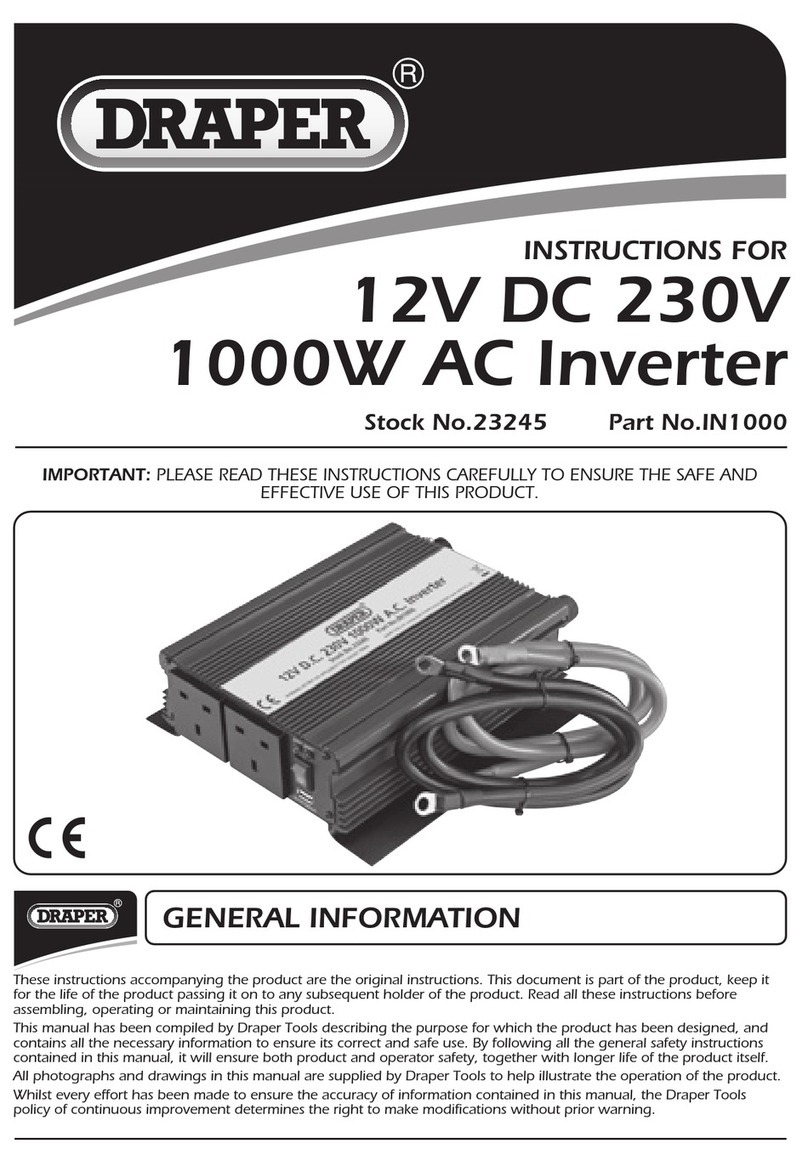
Draper
Draper IN1000 instructions

Austa
Austa AU-1P3002G user manual

SMA
SMA Sunny Central SC 100 installation manual
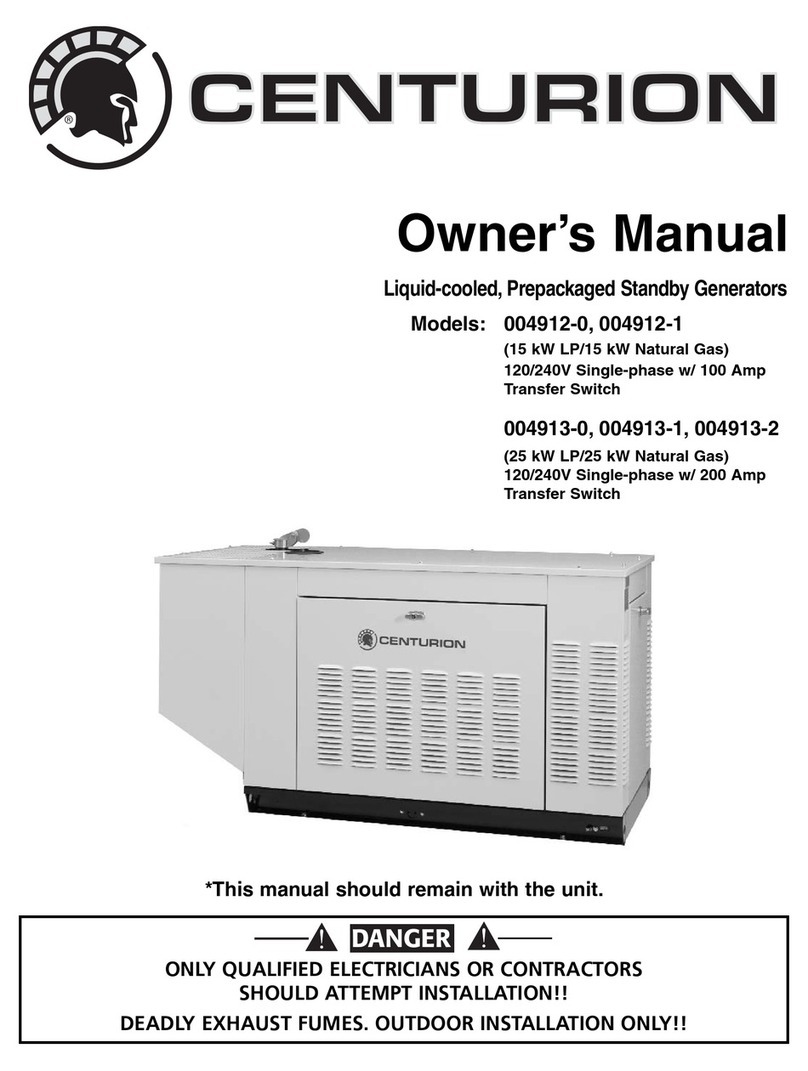
Generac Power Systems
Generac Power Systems 004912-0, 004912-1, 004913-0, owner's manual
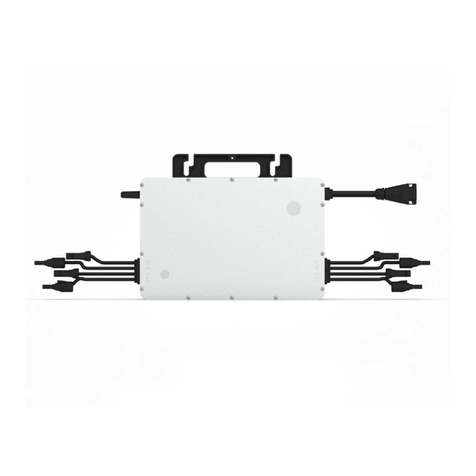
Hoymiles
Hoymiles HM-2000T-S Series Quick installation guide
